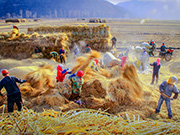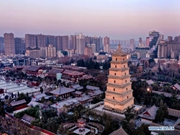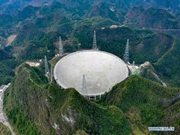

The Kubuqi Desert, the 7th largest desert in China. [Photo by Tanja Herko]
The May moon shines brightly upon Otgonhuar’s small tent. Behind her humble residence, the desert extends its reaches to the influx of tree planters, whose shadows move towards silver dunes, each carrying a sack filled with saplings. For the past two months, Otgonhuar and her 36 workers have been planting trees in the Kubuqi Desert, the seventh-largest desert in China, from dawn until midnight.
“I used to hate my hometown. Endless deserts, suffocating sandstorms, poverty-stricken villages, these were the images of Ordos just a few decades ago,” said the 46-year-old tree planter.
Meaning “palace” in Mongolian, Ordos is home to the Mausoleum of Genghis Khan (1162-1227), founder of the Mongol Empire. Its former glory was swallowed by desertification, primarily due to overgrazing. Maowusu Sandy Area, one of China’s four vast sandy areas, along with the Kubuqi Desert, account for nearly half of the land under the jurisdiction of Ordos. The once beautiful prairies where Otgonhuar’s ancestors had been living for generations were inundated with sand and rocks, while animal husbandry and farming, the traditional pillars of the local economy, gradually declined, resulting in abject poverty.
The situation started to change in the 1990s when the local authorities decided to build a 100-km highway across the desert, encircling it with trees and grass, and then tackling the sand patch by patch.
“The idea of connecting the desert to the outside world has inspired me. If a road can be built in the desert, why can’t we plant trees to restore Ordos to its former glory? With this thinking, many residents like me have embarked on a journey to make the desert greener,” said Otgonhuar.
Otgonhuar’s dream has become a reality over the past three decades, as government-led afforestation efforts, with active participation from enterprises and residents, have successfully stopped the spread of desertification and poverty. In 2016, the forest coverage rate in Ordos reached 26.7 percent. About 70 percent of Maowusu and 25 percent of the Kubuqi Desert underwent afforestation, while the green efforts also lifted about 102,000 inhabitants out of poverty.
Ordos' success has not only benefited the locals, but has also been applauded at the United Nations Convention to Combat Desertification (UNCCD). Chinese President Xi Jinping sent a congratulatory letter to the 7th Kubuqi International Desert Forum held in Ordos in July, which attracted governmental officials, experts and NGOs from 30 countries, praising the “Ordos Kubuqi mode”, calling for more international cooperation to combat desertification, as well as ensure full implementation of the 2030 Agenda for Sustainable Development.
“We’ve shown the world that even the desert can teem and reverberate with greenery, wealth and life. Ordos has provided a template for desert revival, bringing the idea of sustainable development to the world,” said Han Yufei, director of the forestry bureau of Ordos.
 |

 Award-winning photos show poverty reduction achievements in NE China's Jilin province
Award-winning photos show poverty reduction achievements in NE China's Jilin province People dance to greet advent of New Year in Ameiqituo Town, Guizhou
People dance to greet advent of New Year in Ameiqituo Town, Guizhou Fire brigade in Shanghai holds group wedding
Fire brigade in Shanghai holds group wedding Tourists enjoy ice sculptures in Datan Town, north China
Tourists enjoy ice sculptures in Datan Town, north China Sunset scenery of Dayan Pagoda in Xi'an
Sunset scenery of Dayan Pagoda in Xi'an Tourists have fun at scenic spot in Nanlong Town, NW China
Tourists have fun at scenic spot in Nanlong Town, NW China Harbin attracts tourists by making best use of ice in winter
Harbin attracts tourists by making best use of ice in winter In pics: FIS Alpine Ski Women's World Cup Slalom
In pics: FIS Alpine Ski Women's World Cup Slalom Black-necked cranes rest at reservoir in Lhunzhub County, Lhasa
Black-necked cranes rest at reservoir in Lhunzhub County, Lhasa China's FAST telescope will be available to foreign scientists in April
China's FAST telescope will be available to foreign scientists in April